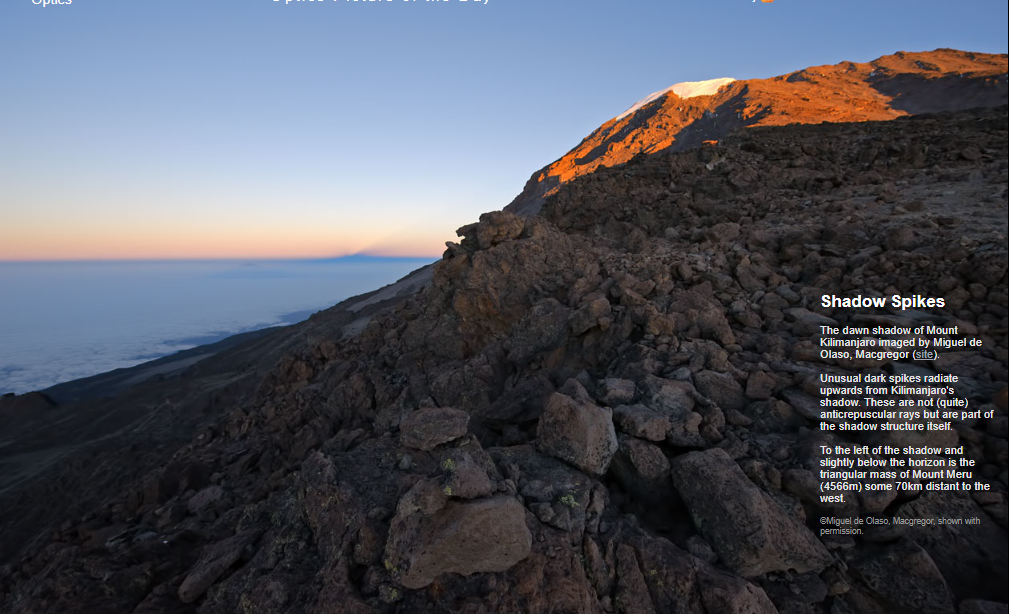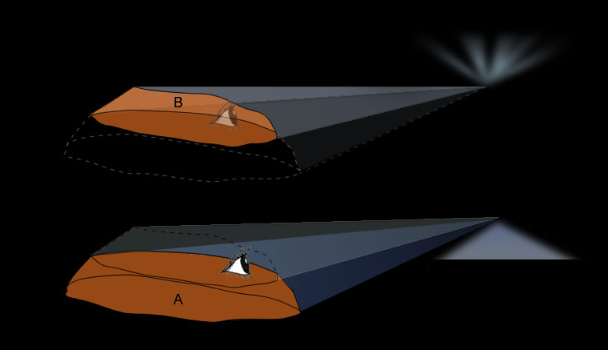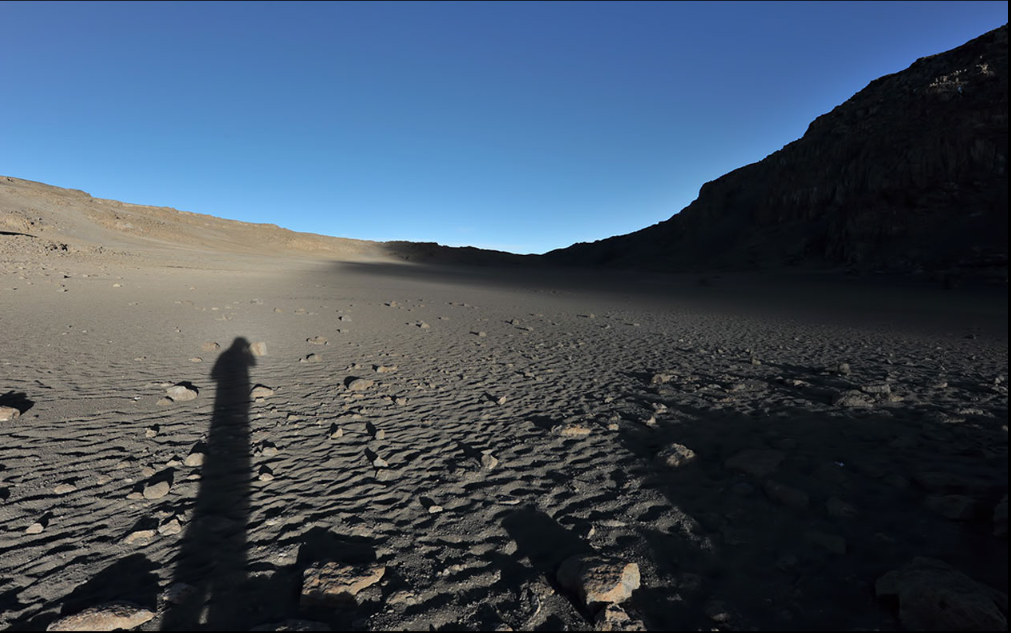OPOD - Mountain Shadow Spikes, Kilimanjaro
OPOD - Mountain Shadow Spikes, Kilimanjaro
When it comes to the majestic Mount Kilimanjaro, there's more to its shadow than meets the eye. In a captivating image captured by Miguel de Olaso, Macgregor, we witness an extraordinary phenomenon: dark spikes radiating upwards from the mountain's shadow. These intriguing spikes are not anticrepuscular rays, but rather an integral part of the shadow structure itself.
To understand the appearance of these upward shadow spikes, it's important to note that Miguel took the photograph from a location situated 1145 meters below the summit, which stands at an impressive 5895 meters high. Imagine slicing Kilimanjaro into two at the level where he stood and focusing solely on the lower slice, labeled as 'A'.
All mountain shadows possess a three-dimensional nature, consisting of dark air. Due to perspective, their elongated, almost parallel shadow tubes appear triangular. Even if the profile of the mountain varies, the shadows consistently exhibit a triangular shape as their parallel lines converge towards a point, similar to parallel railway tracks. Although the diagram depicts the shadow of the lower mountain slice 'A' as greatly foreshortened for convenience, in reality, it is much longer and only slightly tapering.
In Miguel's photograph, the shadow of the mountain slice below him appears as an upward-pointing triangular shape, faintly visible near the horizon. Now, let's imagine that only the upper slice 'B' of the mountain remains above Miguel. The situation remains unchanged; however, to the observer, the mountain appears upside-down. Consequently, it casts an inverted triangular shadow into the sky. As one approaches the summit, the triangle becomes smaller and fainter. In some cases, it may even break into spikes if the remaining mountain features an irregular profile or multiple summits.
Miguel's journey near the summit of Mount Kilimanjaro also offered another captivating sight. At a bone-chilling temperature of -16 Celsius, he described the landscape as resembling the terrain of Mars. The dryness and absence of liquid water, despite the presence of substantial water ice deposits nearby, contributed to this otherworldly resemblance.
Within the image, we can observe a brighter area surrounding Miguel's head and camera. This illumination is known as the 'Opposition effect glow'. In this region, shadows remain hidden behind rocks and undulating soil, resulting in a heightened brightness compared to the surrounding areas. The glow is attributed to retro-reflection by rock minerals and coherent backscattering. Interestingly, a similar opposition effect is observed on Mars. However, it's worth noting that when liquid water is present, another phenomenon called the heiligenschein produces a glow around shadows.
The intricacies of atmospheric optics continue to astound us, and Mount Kilimanjaro offers a captivating canvas for these phenomena. Miguel de Olaso, Macgregor's photograph allows us to appreciate the shadow spikes and opposition effect glow, providing a glimpse into the enchanting world of atmospheric optics.

Shadow Spikes
The dawn shadow of Mount Kilimanjaro imaged by Miguel de Olaso, Macgregor (site).
Unusual dark spikes radiate upwards from Kilimanjaro's shadow. These are not (quite) anticrepuscular rays but are part of the shadow structure itself.
To the left of the shadow and slightly below the horizon is the triangular mass of Mount Meru (4566m) some 70km distant to the west.
©Miguel de Olaso, Macgregor, shown with permission.

The key to the appearance of the upward shadow spikes is that Miguel took the photo 1145m below the 5895m high summit.
Imagine Kilimanjaro sliced into two at the level where he was standing.
Now take away the upper slice to leave only the lower one 'A'.
All mountain shadows are three dimensional and are dark air. They appear to be triangular regardless of their profile because perspective makes their long almost parallel shadow tube recede to a point just as parallel railway tracks do.
In the diagram the shadow of the lower mountain slice A is shown greatly foreshortened to get it on the page, in reality is very long and only slightly tapering.
The shadow of the mountain slice below Miguel appears as the upward pointing triangular shape. In the actual image it is only faintly visible very close to the horizon.
Now imagine that there is only the upper slice 'B' of the mountain above Miguel. The situation is the same except to the observer the mountain is upside-down. It casts an upside down triangular shadow into the sky. The closer you are to the summit the smaller and fainter is the triangle. It might also break into spikes as the summit is approached if the remaining mountain has an irregular profile or multiple summits.

Very close to the summit there was another shadow sight.
The temperature was -16 Celsius. " Except for the blue sky, I think it´s the closest landscape that resembles Mars terrain on Earth. It´s dry, there is no water in liquid form even though there are huge water ice deposits standing nearby. "
Around the shadow of Miguel's head and camera is a brighter area. This is an 'Opposition effect glow'. In that region no shadows are visible because they are hidden behind the rocks and soil undulations casting them. The area consequently appears brighter than the surrounding ones containing shadows. Retro-reflection by rock minerals and coherent backscattering also contribute to the brightness. Mars also shows an opposition effect. The absence of liquid water is important, when that is present a glow around shadows is produced by another effect - the heiligenschein.
Note: this article has been automatically converted from the old site and may not appear as intended. You can find the original article here.
Reference Atmospheric Optics
If you use any of the definitions, information, or data presented on Atmospheric Optics, please copy the link or reference below to properly credit us as the reference source. Thank you!
-
<a href="https://atoptics.co.uk/blog/opod-mountain-shadow-spikes-kilimanjaro/">OPOD - Mountain Shadow Spikes, Kilimanjaro</a>
-
"OPOD - Mountain Shadow Spikes, Kilimanjaro". Atmospheric Optics. Accessed on April 26, 2024. https://atoptics.co.uk/blog/opod-mountain-shadow-spikes-kilimanjaro/.
-
"OPOD - Mountain Shadow Spikes, Kilimanjaro". Atmospheric Optics, https://atoptics.co.uk/blog/opod-mountain-shadow-spikes-kilimanjaro/. Accessed 26 April, 2024
-
OPOD - Mountain Shadow Spikes, Kilimanjaro. Atmospheric Optics. Retrieved from https://atoptics.co.uk/blog/opod-mountain-shadow-spikes-kilimanjaro/.